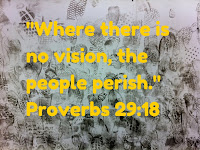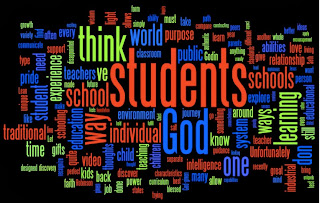One of my most cringe-worthy occurrences as a teacher is when a student simply asks, “Is this for a grade?”
In response, I usually maneuver by the honest inquiry with an ungraceful pirouette. I intend my reply to contain a powerful message about authentic learning and intrinsic motivation, but this is usually masked by a number of “uhhs” and “umms”.
So why do students ask this question and why do I have such a difficult time answering it?
When the school system, teacher, and the parent all hold vastly different visions for the child’s learning, the result is an innocent cry for clarity.
I created a word cloud using the text from all of my blog posts to attempt to understand my own vision better.
I think the largest words (most popular) from my blog’s representation would be replaced by the state and nation’s vision with words like, assess, compete, and knowledge. I highly doubt that the students and God would be at the center of their vision.
With the K-12 education being a $500 billion industry, it would be impossible to maintain a common vision.
Yong Zhao, a professor at the University of Oregon summed up the priorities of America’s public education by saying, “By imposing upon schools and teachers unrealistic, meaningless, and arbitrary goals, high-stakes testing has corrupted the spirit of American education, intoxicated the education environment, and demoralized educators. By forcing schools and teachers to teach to the test, it has narrowed the educational experiences of millions of children and thus deprived our children, especially those from disadvantaged backgrounds, of a real education. It has wasted valuable, precious, and dwindling public funds that could have been put into educating rather than testing our children.”
I’m envious of schools like Anastasis Academy (www.anastasisacademy.com), where students are fed confidence and clarity while inhabiting a passion for learning. When a school can simply be stripped down to the students, their talents and interests, and the community’s resources around them, these kids are valued as a major contributor to their community and society. The way public education is currently run, is rapidly convincing citizens to view schools and students as a burden. How sad.
Ryan Hershey see my blog at
www.faithandeducationcollide.blogspot.com
www.faithandeducationcollide.blogspot.com


